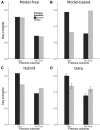Variability in Dopamine Genes Dissociates Model-Based and Model-Free Reinforcement Learning
- PMID: 26818509
- PMCID: PMC4728725
- DOI: 10.1523/JNEUROSCI.1901-15.2016
Variability in Dopamine Genes Dissociates Model-Based and Model-Free Reinforcement Learning
Abstract
Considerable evidence suggests that multiple learning systems can drive behavior. Choice can proceed reflexively from previous actions and their associated outcomes, as captured by "model-free" learning algorithms, or flexibly from prospective consideration of outcomes that might occur, as captured by "model-based" learning algorithms. However, differential contributions of dopamine to these systems are poorly understood. Dopamine is widely thought to support model-free learning by modulating plasticity in striatum. Model-based learning may also be affected by these striatal effects, or by other dopaminergic effects elsewhere, notably on prefrontal working memory function. Indeed, prominent demonstrations linking striatal dopamine to putatively model-free learning did not rule out model-based effects, whereas other studies have reported dopaminergic modulation of verifiably model-based learning, but without distinguishing a prefrontal versus striatal locus. To clarify the relationships between dopamine, neural systems, and learning strategies, we combine a genetic association approach in humans with two well-studied reinforcement learning tasks: one isolating model-based from model-free behavior and the other sensitive to key aspects of striatal plasticity. Prefrontal function was indexed by a polymorphism in the COMT gene, differences of which reflect dopamine levels in the prefrontal cortex. This polymorphism has been associated with differences in prefrontal activity and working memory. Striatal function was indexed by a gene coding for DARPP-32, which is densely expressed in the striatum where it is necessary for synaptic plasticity. We found evidence for our hypothesis that variations in prefrontal dopamine relate to model-based learning, whereas variations in striatal dopamine function relate to model-free learning.
Significance statement: Decisions can stem reflexively from their previously associated outcomes or flexibly from deliberative consideration of potential choice outcomes. Research implicates a dopamine-dependent striatal learning mechanism in the former type of choice. Although recent work has indicated that dopamine is also involved in flexible, goal-directed decision-making, it remains unclear whether it also contributes via striatum or via the dopamine-dependent working memory function of prefrontal cortex. We examined genetic indices of dopamine function in these regions and their relation to the two choice strategies. We found that striatal dopamine function related most clearly to the reflexive strategy, as previously shown, and that prefrontal dopamine related most clearly to the flexible strategy. These findings suggest that dissociable brain regions support dissociable choice strategies.
Keywords: decision-making; dopamine; genetics; reinforcement learning.
Copyright © 2016 the authors 0270-6474/16/361211-12$15.00/0.
Figures





References
-
- Acquas E, Carboni E, de Ree RH, Da Prada M, Di Chiara G. Extracellular concentrations of dopamine and metabolites in the rat caudate after oral administration of a novel catechol-O-methyltransferase inhibitor Ro 40–7592. J Neurochem. 1992;59:326–330. doi: 10.1111/j.1471-4159.1992.tb08907.x. - DOI - PubMed
-
- Calabresi P, Gubellini P, Centonze D, Picconi B, Bernardi G, Chergui K, Svenningsson P, Fienberg AA, Greengard P. Dopamine and cAMP-regulated phosphoprotein 32 kDa controls both striatal long-term depression and long-term potentiation, opposing forms of synaptic plasticity. J Neurosci. 2000;20:8443–8451. - PMC - PubMed
Publication types
MeSH terms
Substances
Grants and funding
LinkOut - more resources
Full Text Sources
Other Literature Sources
Miscellaneous
